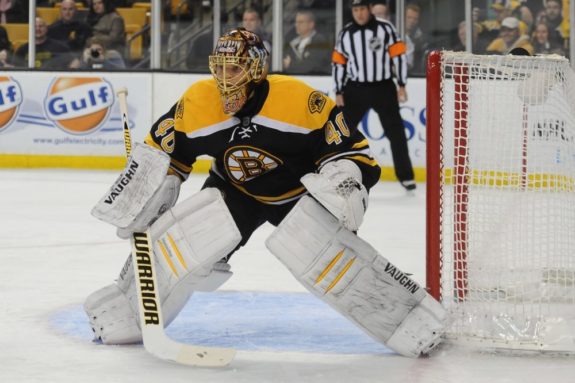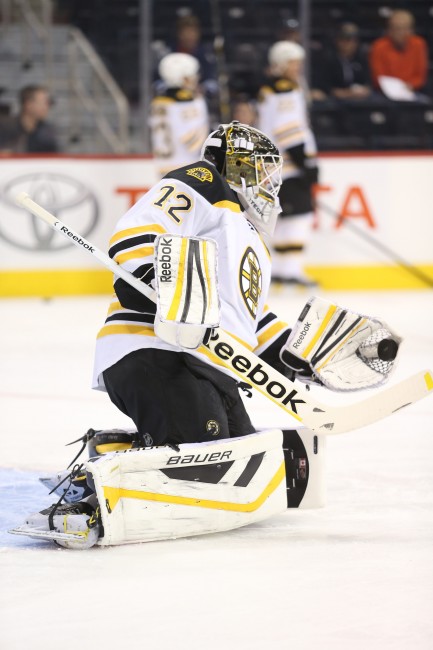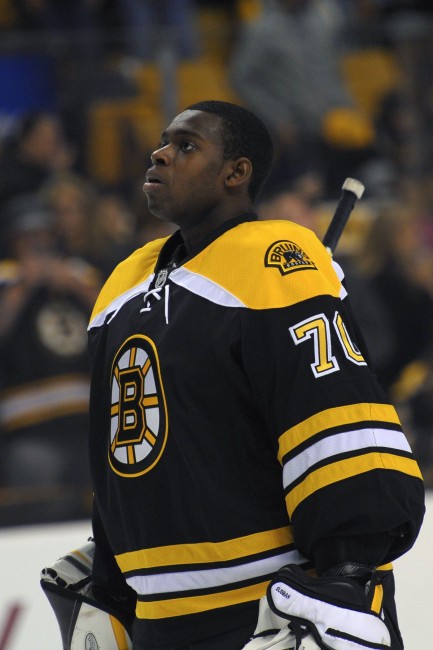The 2014-2015 season did not go as planned for the Boston Bruins. Stanley Cup aspirations quickly turned to playoff desperation, with an extended summer vacation the improbably result. While the team lost key members on offense and defense last summer, Tuukka Rask remained the one constant in net. Last season’s backup netminder, Chad Johnson, left for greener pastures via free agency, vaulting rookie Niklas Svedberg into that role.
The Claude Julien era in Boston has seen a focus on defense, aided by a remarkable stretch of strong goaltending tandems. The season, however, the team saw a large uptick in goals against to a total of 211. That represents the most goals allowed in a season since Julien’s first year at the helm. Allowing 34 goals more than last season is bad, especially when you compound that with the loss of Jarome Iginla and his 30 goals.
This season’s struggles can’t be entirely pinned on the goalies, as the team, at times, played some atrocious defense, but you also can’t absolve them of responsibility. In this, the last of a three part series, we’ll review the season for each of Boston’s goaltenders.
Only players that finished the season with the Boston Bruins organization were included in these grades.
Goaltenders
Tuukka Rask – B+

After winning the Vezina Trophy last year, the organization and fans alike had the greatest of expectations for Tuukka Rask. The season didn’t go exactly as planned for Rask or the Bruins, but there were some positives.
There was initially a bit of criticism for Peter Chiarelli when he handed Tuukka Rask an eight-year, $7 million per year contract in the summer of 2013, considering Rask’s previous career high was 45 games played in a season. In his Vezina campaign, he started a then career high 58 games, posting a stellar .930 save percentage with a goals against average (GAA) of 2.04. This season, he played a whopping 70 games, starting 64 of those, while posting a respectable .922 save percentage and a GAA of 2.30. With that increase in workload, you almost have to expect a regression in statistics.
Despite the 12 additional games played, he was not able to top his win total from the season before, falling two short with 34 wins on the season. While Rask let in more than a few questionable goals this season, he kept the team in a number of games that they had no business winning. Unfortunately, the team didn’t capitalize, particularly in shootouts, where Boston appeared completely incapable of scoring. In 12 shootouts, Rask faced 49 shots, allowing 12 goals, and taking the overtime loss in nine of those games. On average, Rask was facing just over four shots per shootout, which, in most situations, result in a better than 25% success rate.
It wasn’t always pretty, but all things considered, Rask had a strong season. If he can build on this season, combining his strong performance and the increased workload, his contract will end up looking like a steal for the Bruins.
Niklas Svedberg – B-

Niklas Svedberg had some major shoes to fill as he looked to replace Chad Johnson as Tuukka Rask’s backup. In 27 games last season, Johnson posted a .925 save percentage and a GAA of 2.10. Both of those marks, albeit in a smaller sample size, were better than the numbers Tuukka Rask produced this season.
Svedberg made his NHL debut last season, making just one start, in which he posted a .943 save percentage and recorded the win. No one was expecting him to maintain that level of performance, especially as an NHL backup, but it definitely raised the bar.
Svedberg started 14 games, appearing in 18 total, registering a .918 save percentage and a GAA of 2.33, while going 7-5-1. Not quite at Johnson’s level, but still pretty solid. If you compare the team that played in front of Svedberg this year to the team that played in front of Johnson last year, Svedberg’s season might have been even more impressive. The only thing that hampers him in that comparison is that limited number of games he started. In his defense, that might have had more to do with a coach feeling the heat from management than anything else, so I won’t hold that against him.
Since the end of the regular season, Niklas Svedberg has signed with Salavat Yulaev of the KHL. With Svedberg out of the picture, that leaves the Bruins with Tuukka Rask and Malcolm Subban on the roster as goaltending options.
Malcolm Subban – C-

Admittedly, he only made one appearance, so any grade is really unfair. But since there were only three goalies, I figured why not. The Bruins first round pick in the 2012 NHL Entry Draft made his NHL debut on February 20th in St. Louis surrounded by hype. Unfortunately, the hype did not get him through the entire game. He departed moments after the midpoint of the second period, having surrendered three goals on six shots. He did not see the ice again in the NHL for the rest of the season.
You don’t go into the season expecting major contributions from the third goaltender on your depth chart, but it would have been nice to see Subban get a taste of success in the NHL.
He had a respectable season in the AHL, putting himself in contention for the backup spot next year. He may need another year in the AHL, but, at the very least, he’ll apply pressure to whoever ends up as Tuukka Rask’s backup.
How do you think the Bruins goaltenders performed this season? Are these grades fair? Let me know what you think in the comments below or on twitter. In case you missed them, here are the links to Part 1 and Part 2, which feature the grades for Boston’s forwards and defensemen, respectively.